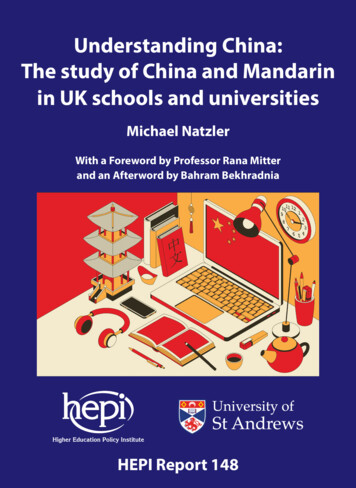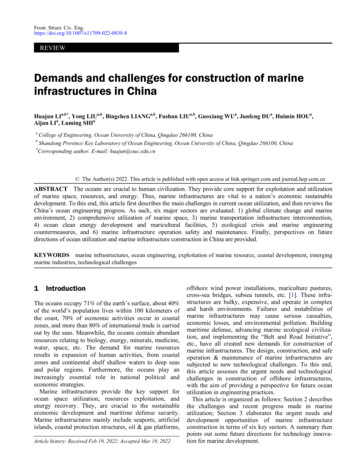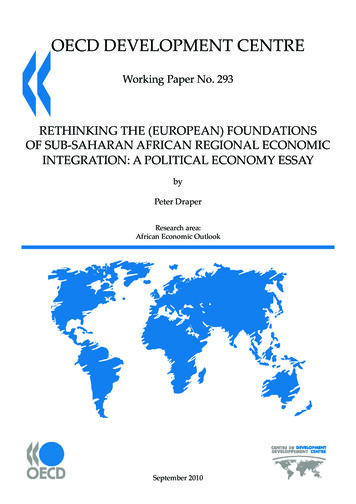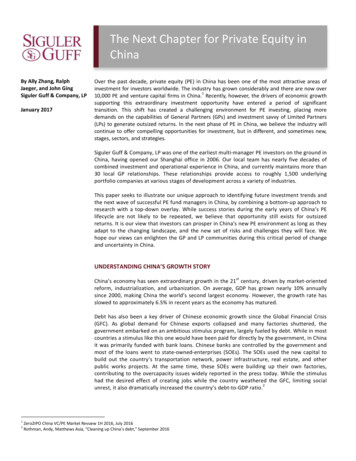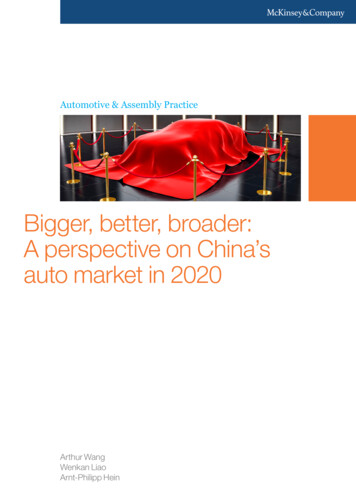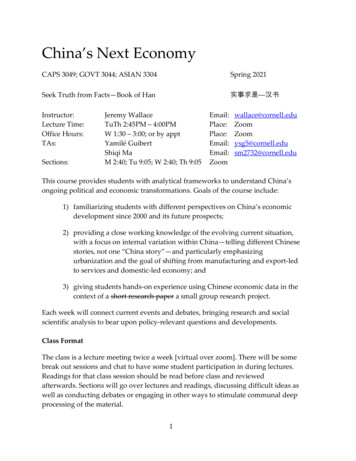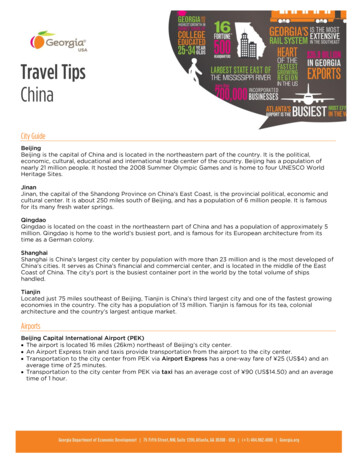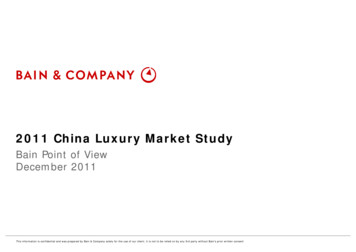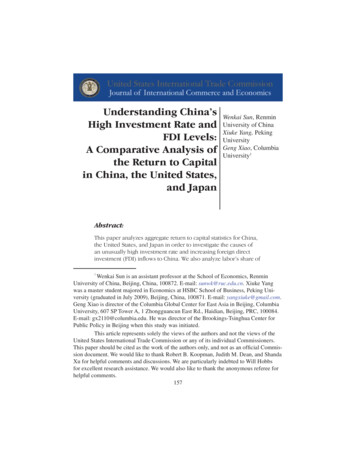
Transcription
Understanding China’sHigh Investment Rate andFDI Levels:A Comparative Analysis ofthe Return to Capitalin China, the United States,and JapanWenkai Sun, RenminUniversity of ChinaXiuke Yang, PekingUniversityGeng Xiao, ColumbiaUniversity1Abstract:This paper analyzes aggregate return to capital statistics for China,the United States, and Japan in order to investigate the causes ofan unusually high investment rate and increasing foreign directinvestment (FDI) inflows to China. We also analyze labor’s share of1Wenkai Sun is an assistant professor at the School of Economics, RenminUniversity of China, Beijing, China, 100872. E-mail: sunwk@ruc.edu.cn. Xiuke Yangwas a master student majored in Economics at HSBC School of Business, Peking University (graduated in July 2009), Beijing, China, 100871. E-mail: yangxiuke@gmail.com.Geng Xiao is director of the Columbia Global Center for East Asia in Beijing, ColumbiaUniversity, 607 SP Tower A, 1 Zhongguancun East Rd., Haidian, Beijing, PRC, 100084.E-mail: gx2110@columbia.edu. He was director of the Brookings-Tsinghua Center forPublic Policy in Beijing when this study was initiated.This article represents solely the views of the authors and not the views of theUnited States International Trade Commission or any of its individual Commissioners.This paper should be cited as the work of the authors only, and not as an official Commission document. We would like to thank Robert B. Koopman, Judith M. Dean, and ShandaXu for helpful comments and discussions. We are particularly indebted to Will Hobbsfor excellent research assistance. We would also like to thank the anonymous referee forhelpful comments.157
output and capital-output ratio statistics to predict future trends inthe return to capital in China. Our findings allow us to come to fourconclusions: (1) China’s high investment rate corresponds to a highreturn to capital in the country, just as high investment rates in theUnited States and Japan historically correspond to a high return tocapital. (2) A comparatively higher return to capital attracted FDIto China. (3) Investment rates among these three countries showno signs of convergence so far. These differences will likely persist,encouraging FDI to continue to flow into China in near future. (4)The return to capital in China will likely decrease in the long run,as the experiences of Japan and the United States indicate, but willonly decrease and become stable after a certain level of capitalstock and development is reached.Keywords: return to capital; investment rate; FDIIntroductionOver the last decade and a half, China maintained an investment rate higherthan that of more advanced economies, including both Japan and the UnitedStates. Over the same period, foreign direct investment (FDI) inflows to theChinese economy grew at an average rate of 19.97 percent per year, increasingfrom 3.5 billion in 1990 to 92.4 billion in 2008.What made China so attractive to investors? In the past few years, this questionhas been heavily debated. China’s National Development and ReformCommission (2005) concluded that rapid industrialization, a high savingsrate, a low consumption rate, and a low efficiency of investment led to thehigh investment rate. Subsequent studies by Li (2007), Hu (2007), Yu (2008)and many others have further explored the high investment rate and the lowconsumption rate in China. Fan (2009) discussed the same topic, comparingthe political systems of China and the United States, and concluded thatChina’s local governments always paid more attention to the interests ofcapital and less to those of labor, resulting in a high investment rate and alow consumption rate. Concerning factors that attract FDI flows into China,Shen et al. (2002) found that the human capital stock significantly affectedthe location choice and investment scale of FDI. Xu et al. (2002) concludedthat FDI was mainly affected by market demand, the capital stock, and the158
exchange rate. Fan and Xu (2009) also discussed the exchange rate’s role inattracting FDI. Li (2004) argued that there was a positive correlation betweenforeign trade and FDI. Huang et al. (2006) pointed out that the transactioncosts of foreign trade, technology spillovers, and market demand significantlyaffected the choice of location for FDI. Luo (2009) studied the source countriesfor FDI and concluded that the source country’s market size and bilateral tradeinfluenced FDI inflow.In this paper, we expand on these findings and seek to understand the effectof the return to capital and international differences in the return to capital onthe investment rate and level of FDI in China. Our main question is whetherthe high investment rate and FDI in China are sustainable. To answer thisquestion, the most intuitive approach is to estimate the return to capital inChina and compare it with that in other major countries, such as the UnitedStates and Japan. If the return to capital in China is consistently high, we mayconclude that the high investment rate in the country is likely to last for anumber of years. And if the return to capital in China is significantly higherthan that for other major countries, we can conclude that foreign capital willcontinue to flow into China. This paper therefore estimates the return tocapital in China, the United States, and Japan; studies key factors that affectthe return to capital; and investigates changes in these factors in order toreveal the trends in China’s return to capital and the future investment climate.MethodologyIn this paper we consider a transaction by a firm, a price taker, to purchase aunit of capital at the margin.2 The real return from this transaction is:2This methodology has its origins in the Hall-Jorgenson rental price equationand has been used in Bai, Hsieh, and Qian (2006). Details on this methodology are givenin the appendix.159
r (t ) PY (t ) MPK j (t )PK j (t ) j PˆY (t ) PK j (t ) (1)Where,r (t ) : The real rate of return to capital;PY (t ) : The price of the output;PK j (t ) : The price of capital j;MPK j (t ) : The marginal physical product of capital j; j : The depreciation rate of capital j;PˆY (t ) : The growth rate of PY (t ) ;PˆK j (t ) : The growth rate of PK j (t )This methodology is simple and straightforward: it relies only on theassumption that firms take output prices as given. More importantly, thismethodology is not dependant on economic structure and thus can be used toestimate the return to capital both in China, an emerging market economy, andin Japan and the United States, which are advanced economies. It is unlikelythat one could observe the marginal physical product of capital directly, but itcan be inferred from data on labor’s share of income. Note that labor’s shareof total income equals total wages over aggregate output. Further note thatwhile equation (5) in the appendix is used for calculations in this paper, it isequivalent to equation (1) above.Data sourcesChinaFor the Chinese Gross Domestic Product (GDP) data, we use two sources:the Chinese Statistical Yearbook 2007 for 1978–2006 and the Comprehensive160
Statistical Data and Materials on 55 Years of New China (1949–2004) for1953–1977. For the investment goods deflator, we use the price indices forinvestment in fixed assets released by China’s National Bureau of Statisticssince 1990; for those before 1990, we simply use the indices from Bai,Hsieh, and Qian (2006).3Labor’s share, theoretically, should be measuredas aggregate compensation to employees over total income. However, theNBS only provides data on the basic condition of China’s labor market inthe industrial sectors. These data do not necessarily reflect the true conditionof the aggregate labor market. Therefore, we estimate labor’s share instead,using provincial annual labor share data, weighted by the share of provincialGDP in the aggregate GDP.To estimate the capital stock in China, we use the perpetual inventory method(PIM). PIM has been widely used to estimate capital stocks (Gerhand, Verbiest,and De Wolf, 1998; Huang, Ren, and Liu, 2002). As appendix equation (6)indicates, the application of PIM requires estimates and assumptions aboutthree parameters: (1) the service life of the investment goods, (2) depreciation,and (3) the constant price of capital invested. For the capital stock in China, wemainly have to consider two kinds of investment goods: (1) construction andinstallation, and (2) machinery and equipment. According to the estimates inWang and Wu (2003), the useful life of construction and installation goods is38 years and that of machinery and equipment is 12 years. This paper employsthe declining-balance method of depreciation, which applies graduallydecreasing depreciation charges over the service life of the asset and thusmight provide a more realistic reflection of actual depreciation. Therefore, theaverage annual depreciation rate of construction and installation is 8 percentand that of machinery and equipment is 24 percent.4In China, the series frequently used to measure annual capital investedis “investment in fixed assets,” which is disaggregated into two types ofinvestment: construction and installation, and purchase of equipment andinstruments. However, Xu (2000) and Bai, Hsieh, and Qian (2006) argued thatthis widely used statistic might not provide an accurate estimate of aggregate3Bai, Hsieh, and Qian (2006) assumed that the price of structures during 1978–89equals the deflator of value added in the construction industry, and that of machinery andequipment equals the output price deflator of the domestic machinery and equipment industry; for the years before 1978, Bai, Hsieh, and Qian (2006) assumed investment goods deflatorequals the growth rate of the aggregate price of fixed capital formation.4In China, the residual value rate ranges from 3 to 5 percent; in this paper we use 4percent as the residual value rate.161
investment in China because the series includes the value of purchased landand expenditures on previously owned machinery and preexisting structures.These should not be regarded as part of reproducible capital stock; doingso might lead to biased estimates of the change in China’s capital stock.Furthermore, the statistic counts only large investment projects, an approachthat underestimates aggregate investment.To circumvent these problems, many researchers recommend another statistic,“gross fixed capital formation,” as an alternative to estimate the change in thecapital stock. This statistic subtracts the value of land sales and the expenditureon preexisting machinery and equipment from the figure for investment infixed assets, and adds expenditures on small investment projects. Because thegross fixed capital formation statistic is not disaggregated into different typesof investment, we assume that the shares of the two types of capital are thesame as those for investment in fixed assets56.The United StatesIn the National Economic Accounts, the U.S. Bureau of Economic Analysis(BEA) provides data for current-dollar and real GDP from 1929 to 2008. TheBEA also provides data on compensation to employees for the same period,which includes wages, salary, and supplements to wages and salary. TheBEA disaggregates fixed assets into private equipment and software, privatenon-residential structures, residential structures, durable goods owned byconsumers, and government-owned fixed assets. Like China and Japan, theUnited States uses geometric depreciation methods for most asset types. TheBEA determines the geometric rate for specific types of assets by dividingthe appropriate declining-balance rate for each asset by the asset’s assumedservice life. The declining-balance rates used by the BEA are primarily derivedfrom estimates made by Hulten and Wykoff, who divided assets into threemajor types: type A assets with extensive data for estimating geometric ratesof depreciation; type B assets with limited studies or other relevant data tosupport estimates of the rate of declining balance; and type C assets withThe data from 1953 to 1977 are from Hsieh and Li (1999), data from 1978 to 2004are from Bai, Hsieh, and Qian (2006), and data from 2005 to 2006 are from China StatisticalYearbook 2007.6We initialize the capital stock of 1952 as the ratio of investment in 1953 to the sumof the average growth rate of investment in 1953–58 and the depreciation rate.5162
no data.7 In this paper, we do not have to conduct in-depth research intothe depreciation rates for different types of assets in the United States, as theU.S. BEA provides data series on capital stock as well as depreciation in theNational Economic Accounts. To obtain the average depreciation rate, wesimply divide the depreciation by the capital stock.JapanThe Economic and Social Research Institute (ESRI), which produces theJapanese national account in the Japan Statistical Yearbook, publishes severalestimates of GDP. The national accounts of the Japan Statistical Yearbook for2009 provide data on aggregate output for 1965–2006, whereas the nationalaccounts of the Historical Statistics of Japan (2010) provide data on GDPfor 1980–2003 under the 1993 System of National Accounts (93SNA) and for1955–98 under the 1968 System of National Accounts (68SNA). In this paper,we use the data of aggregate output in the Japan Statistical Yearbook 2009 for1965–2006 and the data in the Historical Statistics of Japan for 1955–64. Fordata on compensation to employees, we use the Japan Statistical Yearbook2009 for 2003–06, 93SNA for 1980–2002, and 68SNA for 1955–79.One of the primary categories of capital stock for which estimates are givenin the Japan Statistical Yearbook is net capital stock (NCS), which coverssuch items as buildings, structures, transport equipment, and machinery. Asecond is gross capital stock of private enterprises (GCSPE), which covers allfixed assets, excluding residential buildings owned by private corporationsor unincorporated enterprises and fixed assets owned by private nonprofitinstitutions. The main limitation of the NCS is that it is disaggregated into onlysix categories of tangible assets: (1) dwellings, (2) other buildings, (3) otherstructures, (4) transport equipment, (5) other machinery and equipment,and (6) cultivated assets. The current asset classification is too aggregatedto fully satisfy our research needs, as high- and low-depreciation assets arebundled together in some of the classifications. However, the GCSPE, whichis frequently used as the main data source for analysis of production byindustry, is also a flawed measure of productive capacity because it does nothave asset categories. Moreover, the GCSPE only counts the capital stock forprivate enterprises, which does not provide an appropriate measure for thecapital stock of the aggregate economy. Because of this, we chose to use NCSas the capital stock of Japan in this paper, and added total inventories.7This information is primarily extracted from “BEA Depreciation Estimates” at theBEA website.163
According to the ESRI, depreciation in NCS is based on the geometricmethod for dwellings, transport equipment, etc. The residual value rate is50 percent for cultivated assets and 10 percent for other assets. We calculatethe corresponding depreciation rate in table 18 and compute the aggregatedepreciation rate as a weighted average of depreciation rates by types ofassets, using the capital stock shares as weights.Return to Capital in China, the United Statesand JapanWith the above-mentioned data in hand, we can estimate the return to capital.In table 2, we provide our estimates of the return to capital in China and listthe variables used to calculate it. In tables 3 and 4, we do the same for thereturn to capital in Japan and in the United States.Return to Capital in ChinaAs shown in figure 1, the return to capital in China varied between 23.17percent in 1978 and 21.82 percent in 2006, averaging over 20 percent duringthis 28-year period. However, there was a drastic fluctuation in the return tocapital in China between 1992 and 1994, with a sharp increase in 1993 anda rapid decline in 1994. The spike in 1993 was likely due to a sharp increasein the growth rate of investment goods prices in 1993, which rose from 15.52percent in 1992 to 29.35 percent in 1993. The rapid drawdown in the returnto capital in China in 1994 was likely due to a rapid decline in the growth rateof investment goods prices in 1994, which fell from 29.35 percent in 1993 to10.25 percent in 1994.Return to Capital in JapanAs shown in figure 2, the return to capital in Japan was extremely volatilebetween 1956 and 2006, with a high point of 39.43 percent in 1961 and alow of 5.4 percent in 1994. This metric seems strongly correlated with thecountry’s economic cycle. From 1956 to 1974, as Japan rebuilt its lost industrialcapacity and experienced a series of economic booms, the return to capital inJapan was at its highest level, averaging above 31 percent. In the mid-1970s,8All tables and figures are located after the Appendix.164
Japan faced a severe economic challenge—the 1973 world oil crisis—whichshocked its heavily petroleum-dependent economy. During this period, thereturn to capital plunged from 30.38 percent in 1974 to 13.94 percent in 1975.Throughout the last five years of the 1970s, this figure fluctuated around 14percent. In the mid-1980s, the return to capital in Japan began another periodof increase that continued until the country entered a recession in 1992. From1993 to 2006, the return to capital in Japan remained relatively stable, albeitrelatively low, with an average of 9 percent.The Return to Capital in the United StatesAs shown in figure 3, the return to capital in the United States fell fromaround 15 percent after the Second World War to around 5 percent in the lastdecade. During the late 1920s, the United States enjoyed a period of sustainedprosperity known as the Roaring Twenties. Even in the first three years afterthe Wall Street Crash of 1929, the United States maintained a return to capitalas high as 15 percent. This, however, was likely due to the negative growthrate of the GDP deflator. As the Great Depression devastated the UnitedStates’ economy, the return to capital dropped to around 6 percent by the mid1930s. However, the depression also led to U.S. government efforts to restartthe economy, and the return to capital from 1935 to 1945 averaged around10 percent. During the period of postwar prosperity from 1945 to 1973, thereturn to capital in the United States fluctuated between 12 and 4 percent,averaging roughly 8 percent. The oil crisis in 1973, which caused the soaringinflation of the 1970s, badly hurt the U.S. economy. The return to capital inthe United States averaged below 1 percent for a decade starting in 1974. Tostimulate the American economy after a recession in the early 1980s, RonaldReagan introduced expansionary fiscal policies, which led to an economicrecovery starting in 1983. The return to capital in the United States averagedabout 6 percent from then until the Clinton administration. The six-year spanfrom 1994 to 2000 witnessed the emergence of a technology-driven “neweconomy,” and the return to capital in the United States during this periodaveraged above 7 percent. Between 2000 and 2007 the U.S. return to capitalremained relatively stable, averaging around 6 percent.165
Investment Rates and FDI: From thePerspective of Return to CapitalThe Investment Rate in ChinaFigure 4 shows that the investment rate in China increased from 29.46 percentin 1978 to 42.75 percent in 2006. In the intervening period, as noted earlier,the return to capital in China fluctuated around 22 percent. This indicates apositive relationship between the return to capital and the investment rate.We believe the investment rate in China was high during the period of 1978to 2006 because the return to capital in China was the highest in the world,which heightened investors’ willingness to invest in the country.The Investment Rate in JapanAs shown in figure 5, the investment rate in Japan increased from 26.80percent in 1956 to 39.02 percent in 1970 and declined to 23.46 percent in2006, with an average of 30.45 percent over the entire period. From 1956 to1970, as discussed earlier, the return to capital in Japan increased from 31.95to 38.38 percent, averaging 32.36 percent. After 1970, the return to capital inJapan dropped to 12.79 percent by 2006, averaging only 13.62 percent. Theevidence from Japan indicates that investors were willing to invest more whenthe return to capital was high and invest less when the return to capital waslow.The Investment Rate in the United StatesFrom 1929 to 2007, the investment rate and the return to capital in the UnitedStates were highly correlated. Figure 6 shows that the investment rate in theUnited States declined during the Great Depression in the early 1930s butincreased in the following years, rising from 15.60 percent in 1933 to 29.68percent in 1950, the year that marked the highest investment rate in theUnited States for 1930–2007. After 1950, the investment rate in the UnitedStates fluctuated between 24 and 30 percent, with an average of around 27percent. As discussed above, the return to capital in the United States, after adecline during the Great Depression period, increased from 1.27 percent in1934 to 11.08 percent in 1950, with a slight decrease in the late 1940s whenthe investment rate fell. Between 1950 and 2007, the return to capital in theUnited States remained relatively stable except the period during 1974-1982.166
Impacts on FDI inflows to ChinaIn the observed period, FDI played a determining role in investment in China:its high level contributed to the high investment rate. One important factorthat affected cross-border capital flows was the disparity in the returns tocapital across countries. Figure 7 shows the differences in the returns to capitalbetween China and the world’s two largest capital export/import countries,Japan and the United States, as well as the growth rate of FDI inflows in China.We can see that the growth of FDI inflows in China increased significantlywhen the return-to-capital disparities between China and Japan and Chinaand the United States widened, which is especially evident from 1992 to 1993.The correlation coefficient between the growth rate of FDI inflows and thedifference between the return to capital in China and Japan was as high as0.819; for the United States and China, the correlation was 0.799.Factors That Affect Return to CapitalMarginal Effect of FactorsFigures 8 and 9 show that the marginal effects of labor’s share and the capitaloutput ratio on the return to capital are always negative, which suggests thatan increase in labor’s share of income and the capital-output ratio will leadto a decrease in the return to capital. In the long run, however, the marginaleffects of labor’s share and the capital-output ratio seem to converge to zero.The return to capital changes significantly when it is at a high level, andchanges little when it is at a relatively lower level. The return to capital is thusable to become stable again after a sharp decline. In the short run, the changein marginal returns results from the changes in labor’s share of income andthe capital-output ratio. In the following section, we will discuss how thesefactors change over time and how they affect the return to capital.Trends in Key FactorsAs appendix equation (9) indicates, the marginal impact of an increase inlabor’s share of income on the return to capital is always negative—i.e., thereturn to capital decreases as labor’s share increases. Figure 10 shows thatlabor’s share of income in Japan rose from 41.44 percent in 1956 to 51.6percent in 2006, while that of the United States rose from 51.43 percent in167
1930 to 56.63 percent in 2007. However, labor’s share of income in China fellfrom 49.67 to 40.61 from 1978 to 2006. Labor’s share of income in China ismuch lower than those in either Japan or the United States, which is why thecountry’s return to capital is higher. This is very intuitive: when labor receivesless compensation, capital will earn more, which leads to a higher return tocapital.There are two major reasons that labor’s share of income is so low in China.China has a large manufacturing sector, and laborers are paid less than thosewho work in the service industry. Also, an abundance of rural migrant workersprovide a steady flow of cheap labor for manufacturers; this is the chief reasonthat labor’s share of income in China has actually decreased during the lasttwo decades. In the future, as the economy develops, workers in China willundoubtedly seek better compensation. This will lead to an increase in labor’sshare of income in China, just as Japan and the Unites States saw increasesin the past. The increase of labor’s share of income will ultimately reducethe return to capital in China. However, it seems likely that Chinese labor’sshare of income will remain at a lower level than the Japanese or Americanfor a number of years, given China’s manufacturing-based economy and itspersistently large flow of rural workers into manufacturing.What is the economic meaning of a high capital-output ratio? Does it indicatea low GDP, or imply a high capital stock? In the cases of Japan and the UnitedStates, the two largest economies in the world, the answer should be a highcapital stock. It’s natural that Japan and the United States attracted significantamounts of investment during the 20th century, which led to the accumulationof large capital stocks in the two countries. Figure 11 shows that the capitaloutput ratio in Japan increased from 1.71 in 1956 to 2.41 in 2006, while thatof China rose only a slightly—from 1.47 in 1978 to 1.74 in 2006. Although thecapital-output ratio in the United States experienced no remarkable changeduring the period of 1930 to 2007, it persisted at 3.4, which was much higherthan both China’s and Japan’s.From the experiences of Japan and the United States we can predict that thecapital stock in China will increase in the future, which potentially may leadto an increase in the capital-output ratio. The high return to capital in Chinais likely to attract more investment, which will increase the capital stock andlead to a high capital-output ratio. However, it seems unlikely that the capitaloutput ratio in China will experience a significant increase in the near futurebecause China has the world’s third largest GDP and a fast-growing economy.168
The lower capital-output ratio in China relative to those of Japan and theUnited States will likely cause the return to capital in China to remain thehighest of the three countries in the years ahead.Trends in Return to Capital and the FutureInvestment Climate in ChinaAs shown in figure 12, the return to capital in Japan decreased from 31.95percent in 1956 to 12.79 percent in 2006, while that of the United Statesdecreased from 15.28 percent in 1930 to 6.94 percent in 2007, indicating thatthe return to capital seems to decline in the long run. Increases in labor’s shareof income and the capital-output ratio seem to follow the development of theeconomy, leading to a decline in the return to capital. Also, the evidence fromJapan and the United States indicates that the return to capital remains highduring the early stages of economic booms. From 1965 to 1980, for example,the period that marked the economic booms of Japan, the return to capital inJapan averaged above 28 percent. From 1978 to 2006, the period that markedChina’s “Reform and Opening Up” movement, the return to capital in Chinawas also very high.As stated above, the experiences of major developed countries indicate thatthe return to capital in China will decrease in the future because of increasesin labor’s share of income and the capital-output ratio. However, it seems thatthe return to capital in China will remain higher than that of Japan and thatof the United States in the near future because labor’s share and the capitaloutput ratio are still very low and are unlikely to significantly increase any timesoon. Considering the experience of Japan, whose return to capital convergedto that of the United States after more than 40 years of economic development,we can conclude that, considering the size of its economy, China will still beable to enjoy a high return to capital for at least 10 more years. In addition,as the return to capital in China is significantly higher than those of othermajor countries, foreign capital will continue to flow into China, especiallyas China increasingly opens more sectors to foreign investors as part of thecommitments it made toward entry into the WTO.169
DiscussionIn this paper, we take labor’s share of income and the capital-output ratio tobe the primary determinants of the high return to capital observed in China.They therefore have a direct impact on the calculations used. However, thereare also many other secondary considerations that may indirectly affect thereturn to capital, but which are beyond the scope of this paper.For example, because China’s financial market is not fully developed,financing costs are high. There are also many investment inefficiencies inChina (NDRC 2005). In addition, because China is still a transition economy,there are many investment uncertainties, including regulations, pricingmechanisms, and the level of market development. Businesses face morerisk because of these factors, and as a result they demand a higher return tocapital as compensation. Moreover, many sectors in the Chinese market arestill monopolies: this imperfect competition allows the return to capital inthose sectors to be comparatively high. In the long run, as China’s economydevelops, changes in these factors will contribute to decreases in the returnto capital.Theoretically, a high investment rate and a quickly growing stock of FDI inChina will have a
1 Wenkai Sun is an assistant professor at the School of Economics, Renmin University of China, Beijing, China, 100872. E-mail: sunwk@ruc.edu.cn. Xiuke Yang was a master student majored in Economics at HSBC School of Business, Peking Uni-versity (graduated in July 2009), Beijing, China, 100871. E-mail: yangxiuke@gmail.com.
